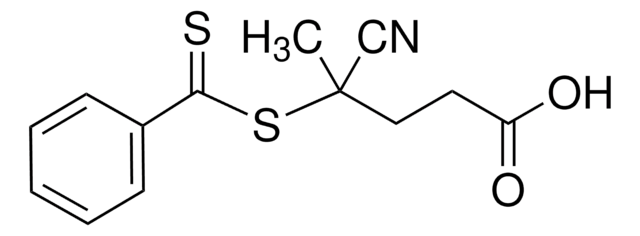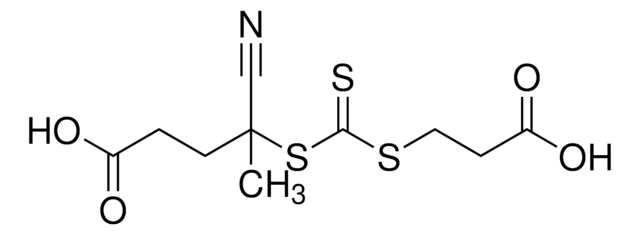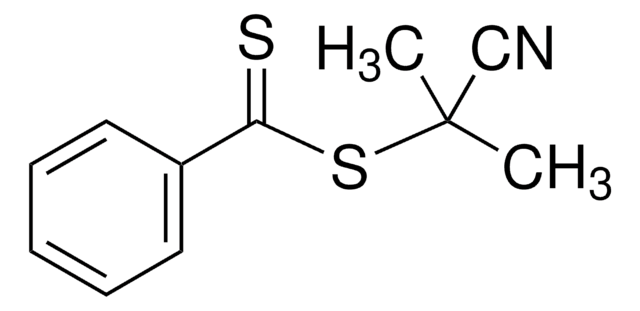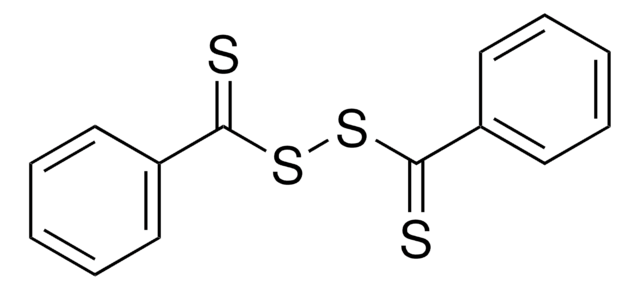758353
4-Cyano-4-(phenylcarbonothioylthio)pentanoic acid N-succinimidyl ester
Synonym(s):
4-Cyano-4-(phenylcarbonothioylthio)pentanoic acid N-hydroxysuccinimide ester, 4-Cyano-4-[(phenylthioxomethyl)thio]-2,5-dioxo-1-pyrrolidinyl ester pentanoic acid, NHS protected RAFT, RAFT polymerization agent
About This Item
Recommended Products
form
solid
mp
175-185 °C
storage temp.
2-8°C
SMILES string
S(C(CCC(=O)ON2C(=O)CCC2=O)(C)C#N)C(=S)c1ccccc1
InChI
1S/C17H16N2O4S2/c1-17(11-18,25-16(24)12-5-3-2-4-6-12)10-9-15(22)23-19-13(20)7-8-14(19)21/h2-6H,7-10H2,1H3
InChI key
XQQHRPPQBDALBV-UHFFFAOYSA-N
General description
Application
RAFT agent for controlled radical polymerization; This is the NHS protected version of 722995; well suited for methacrylates and methacrylamides; Chain Transfer Agent (CTA)
signalword
Danger
hcodes
pcodes
Hazard Classifications
Acute Tox. 3 Oral
Storage Class
6.1C - Combustible acute toxic Cat.3 / toxic compounds or compounds which causing chronic effects
wgk_germany
WGK 3
flash_point_f
Not applicable
flash_point_c
Not applicable
Choose from one of the most recent versions:
Already Own This Product?
Find documentation for the products that you have recently purchased in the Document Library.
Articles
The modification of biomacromolecules, such as peptides and proteins, through the attachment of synthetic polymers has led to a new family of highly advanced biomaterials with enhanced properties.
We presents an article about a micro review of reversible addition/fragmentation chain transfer (RAFT) polymerization. RAFT (Reversible Addition/Fragmentation Chain Transfer) polymerization is a reversible deactivation radical polymerization (RDRP) and one of the more versatile methods for providing living characteristics to radical polymerization.
We presents an article about Copper(I)-mediated Living Radical Polymerization in the Presence of Pyridylmethanimine Ligands, and the emergence of living radical polymerization mediated by transition metal catalysts in 1995, which was a seminal piece of work in the field of synthetic polymer chemistry.
Applying ARGET ATRP to the Growth of Polymer Brush Thin Films by Surface-initiated Polymerization
Protocols
We presents an article featuring procedures that describe polymerization of methyl methacrylate and vinyl acetate homopolymers and a block copolymer as performed by researchers at CSIRO.
Our team of scientists has experience in all areas of research including Life Science, Material Science, Chemical Synthesis, Chromatography, Analytical and many others.
Contact Technical Service
![4-Cyano-4-[(dodecylsulfanylthiocarbonyl)sulfanyl]pentanoic acid 97% (HPLC)](/deepweb/assets/sigmaaldrich/product/structures/204/925/30ae6ca0-5b0b-4963-a061-7e5e3d1a85af/640/30ae6ca0-5b0b-4963-a061-7e5e3d1a85af.png)



![4-Cyano-4-[(dodecylsulfanylthiocarbonyl)sulfanyl]pentanol](/deepweb/assets/sigmaaldrich/product/structures/839/520/64c23004-f340-460f-a379-8670a35d0433/640/64c23004-f340-460f-a379-8670a35d0433.png)




